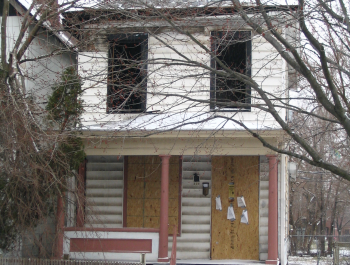Image

Bruce Luecke, Interim President and CEO, Homeport
Challenge: When a highway development cut through the King Lincoln District in Columbus, OH, residents of the formerly vibrant and culturally rich neighborhood were forced to leave the area for their needs and entertainment. Crime and poverty increased in the neglected community. An innovative approach was needed to revitalize the neighborhood.
In the 1930s and ‘40s, the King Lincoln District in Columbus was a thriving African-American community with daily parades, bustling theatres and night clubs where the nation’s top jazz entertainers, such as Miles Davis and Art Blakey, regularly performed. It was a thriving, self-sufficient neighborhood; everything needed was within walking distance, including grocery stores, doctor’s offices, hospitals and schools.
Then, in the early ‘60s a highway development cut through the District and as local businesses declined and residents began to leave the area. Homes and businesses were boarded up and crime rates soared. The once vibrant community became a place riddled with poverty, unemployment, and empty buildings.
King Lincoln District is the site of Poindexter Village, one of the nation’s first public housing projects dedicated by President Roosevelt in 1940. In the late 1970s, President Carter later came to proclaim a revival of the area through new housing and stores, but the restoration was unsuccessful.
The key to successfully improving the area would be patience, a methodical approach and several partnerships. When interviewed about the neighborhood, former mayor of Columbus Michael B. Coleman said, “The way to deal with bringing back a neighborhood is holistically. It’s not a project. It’s twenty projects. It’s making an entire holistic effort of housing, commercial, entertainment, office, the works.”
The City of Columbus dedicated millions of dollars to reviving this historic area with a variety of improvements. City officials asked Homeport to handle improving housing in the area. Located in central Ohio, Homeport has been building vibrant communities and revitalizing neighborhoods since 987. Homeport’s place-based strategy for the neighborhood’s development was to create a concentrated and critical mass of homeownership by stabilizing small portions of the neighborhood, block by block. We also began supporting the broader neighborhood through community improvement and engagement activities to eliminate blight and serve as a catalyst for new residential and commercial investment.
Homeport and the City chose to initially focus on 21st Street. Less than ten of the nearly 60 homes that lined the street were occupied. Homeport was careful not to displace anyone and only purchased vacant lots and houses to rebuild or rehab into affordable and sustainable homes. Homeport redeveloped over half of the homes on the street.
The King-Lincoln District began to come alive again with city investments to attract businesses and revive local theatres and the construction of a new bridge connecting the neighborhood with downtown Columbus. Instead of just being a neighborhood that people drove through to get to other places, people began to move back into the area. As Homeport continued its work, private developers began investing in homes on other streets. Once a base of new homes and engaged residents was established on 21st Street, Homeport expanded the project to 20th and 22nd Streets. By concentrating block by block, then street by street, we began to revitalize the neighborhood.
 From 2004 to 2015, Homeport had an impact on more than 100 homes through new construction, renovations, owner-occupied home repairs and community improvement projects, which includes building 69 new homes and condominiums and 30 repair projects on owner-occupied homes. We coordinated 15,000 hours of volunteer service in the neighborhood.
From 2004 to 2015, Homeport had an impact on more than 100 homes through new construction, renovations, owner-occupied home repairs and community improvement projects, which includes building 69 new homes and condominiums and 30 repair projects on owner-occupied homes. We coordinated 15,000 hours of volunteer service in the neighborhood.Homeport intentionally worked with partners to reestablish a mixed-income neighborhood that would continue to be affordable for existing residents. As the revitalization continued, buyers from throughout central Ohio began to identify “North of Broad” as a neighborhood of choice. Interest in its homes came from buyers at every income level, an indicator of the success of Homeport’s revitalization efforts.
Homeport homeowners range from young professionals to retirees, mirroring the King Lincoln District’s historic diversity. One homeowner was so impressed with the quality of his home and the values of the neighborhood, that prior to even closing on his home he began to encourage his mother to buy a Homeport home, which she did the following year.
The District may not return to being the same neighborhood it once was, but it is once again becoming a place to live, shop and work. While there are still more homes and streets to revitalize, people are moving back to the King-Lincoln District for the first time in decades. Businesses are beginning to develop and succeed. And the Lincoln Theatre, one of the main attractions when the District was in its prime, has been restored and now regularly hosts performances. The District has been transformed into a new neighborhood without losing the cultural richness of its original days.
The Homeport effort illustrates the following lessons learned:
- successful revitalization takes a concentrated, place-based approach
- rather than focus on large projects, moving house-by-house, street-by-street, leads to a slow but steady rebuilding of a neighborhood
- by creating mixed-income housing, the neighborhood can be an affordable place for the original residents and welcome in needed new residents.

